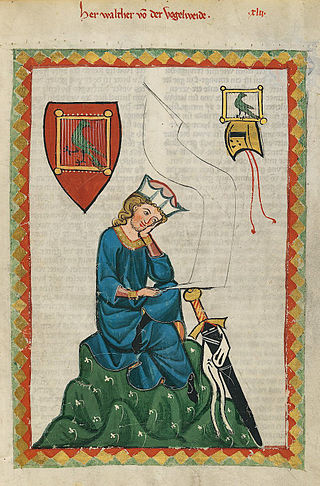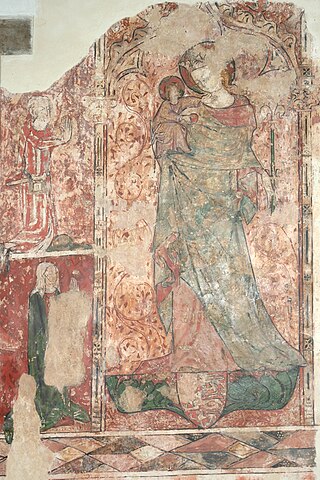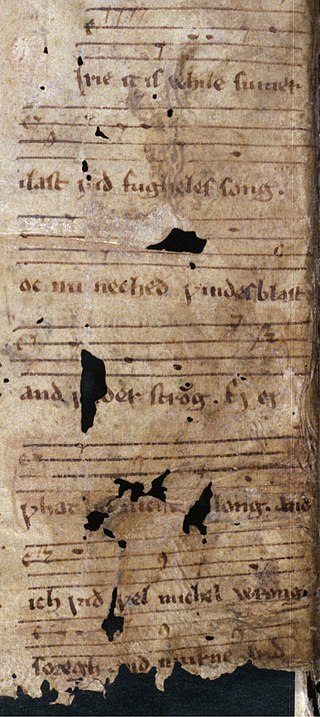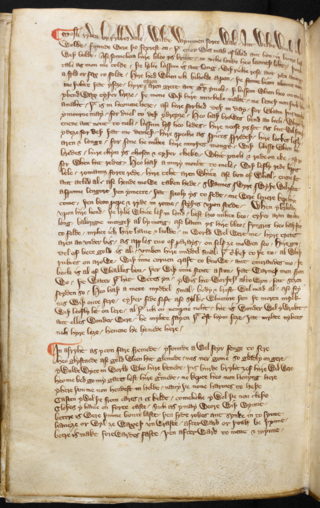
Minnesang was a tradition of lyric- and song-writing in Germany and Austria that flourished in the Middle High German period. This period of medieval German literature began in the 12th century and continued into the 14th. People who wrote and performed Minnesang were known as Minnesänger, and a single song was called a Minnelied.

"Sumer is icumen in" is the incipit of a medieval English round or rota of the mid-13th century; it is also known variously as the Summer Canon and the Cuckoo Song.
Middle English lyric a genre of English literature, is characterized by its brevity and emotional expression. Conventionally, the lyric expresses "a moment," usually spoken or performed in the first person. Although some lyrics have narratives, the plots are usually simple to emphasize an occasional, common experience. Even though lyrics appear individual and personal, they are not "original"; instead, lyrics express a common state of mind. Those states of mind are wide in range. Some deal with religious topics pertaining to Jesus or the Virgin Mary, focusing on Christ's sacrifice and salvation, or Mary's roles as a mother and intercessor. Other religious topics focus on Adam and the Fall, or the necessity of faith. Others are secular, focusing on ale, women, and the simple joys of life. Some are sarcastic, satiric, humorous, or even crude.

"I syng of a mayden" is a Middle English lyric poem or carol of the 15th century celebrating the Annunciation and the Virgin Birth of Jesus. It has been described as one of the most admired short vernacular English poems of the late Middle Ages.
When The Nightingale Sings is a Middle English poem, author unknown, recorded in the British Library's Harley 2253 manuscript, verse 25. It is a love poem, extolling the beauty and lost love of an unknown maiden.

Christ I, is a fragmentary collection of Old English poems on the coming of the Lord, preserved in the Exeter Book. In its present state, the poem comprises 439 lines in twelve distinct sections. In the assessment of Edward B. Irving Jr, "two masterpieces stand out of the mass of Anglo-Saxon religious poetry: The Dream of the Rood and the sequence of liturgical lyrics in the Exeter Book ... known as Christ I".

"Lullay, mine liking" is a Middle English lyric poem or carol of the 15th century which frames a narrative describing an encounter of the Nativity with a song sung by the Virgin Mary to the infant Christ. The refrain is an early example of an English lullaby; the term "lullaby" is thought to originate with the "lu lu" or "la la" sound made by mothers or nurses to calm children, and "by" or "bye bye", another lulling sound.

The Harley Lyrics is the usual name for a collection of lyrics in Middle English, Anglo Norman, and Latin found in Harley MS 2253, a manuscript dated ca. 1340 in the British Library's Harleian Collection. The lyrics contain "both religious and secular material, in prose and verse and in a wide variety of genres." The manuscript is written in three recognisable hands: scribe A, scribe B or the Ludlow scribe, and scribe C.

Anglo-Saxon riddles are a significant genre of Anglo-Saxon literature. The riddle was a major, prestigious literary form in early medieval England, and riddles were written both in Latin and Old English verse. The pre-eminent composer of Latin riddles in early medieval England was Aldhelm, while the Old English verse riddles found in the tenth-century Exeter Book include some of the most famous Old English poems.
The Proverbs of Hendyng is a poem from around the second half of the thirteenth century in which one Hendyng, son of Marcolf, utters a series of proverbial stanzas. It stands in a tradition of Middle-English proverbial poetry also attested by The Proverbs of Alfred; the two texts include some proverbs in common. The rhyme scheme is AABCCB.
Foweles in the frith is a short, five-line Middle English poem. It is found in a manuscript from the thirteenth century containing mostly legal writings, and is accompanied by a musical score for two voices.
Thorlac Francis Samuel Turville-Petre is an English philologist who is Professor Emeritus and former head of the School of English at the University of Nottingham. He specializes in the study of Middle English literature.
"Maiden in the mor lay" or "The Maid of the Moor" is a Middle English lyric of the early 14th century, set to a melody which is now lost. The literary historian Richard L. Greene called it "one of the most haunting lyrics of all the Middle Ages", and Edith Sitwell thought it "a miracle of poetry". It is a notoriously enigmatic poem, perhaps devotional, perhaps secular, which depicts a maiden in the wilderness who lives on flowers and spring-water. Critics are divided in their interpretation of her: she may be the Virgin Mary, Mary Magdalene, a water-sprite, or an ordinary human girl. The 14th-century bishop Richard de Ledrede's dissatisfaction with this song led to an alternative lyric for it being written, a Latin religious poem, Peperit virgo.

"Alysoun" or "Alison", also known as "Bytuene Mersh ant Averil", is a late-13th or early-14th century poem in Middle English dealing with the themes of love and springtime through images familiar from other medieval poems. It forms part of the collection known as the Harley Lyrics, and exemplifies its best qualities. There may once have been music for this poem, but if so it no longer survives. "Alysoun" was included in The Oxford Book of English Verse, The Norton Anthology of English Literature, and The Longman Anthology of British Literature. It has been called one of the best lyrics in the language.

“Mirie it is while sumer ilast” is a Middle English song of the first half of the 13th century. It is about the longing for summer in the face of the approaching cold weather. It is one of the oldest songs in the English language, and one of the few examples of non-liturgical music from medieval England. The manuscript was found together with two old French songs in a book of Psalms in the Bodleian Library. It was rediscovered at the end of the 19th century and made accessible to experts in 1901. It was arranged and published in a modern form for the first time by Frank Llewellyn Harrison.
"The knight who could make cunts speak" is a French fabliau. Seven versions of it remain, including one in MS Harley 2253.
"Lenten ys come with love to toune", also known as "Spring", is an anonymous late-13th or early-14th century Middle English lyric poem which describes the burgeoning of nature as spring arrives, and contrasts it with the sexual frustration of the poet. It forms part of the collection known as the Harley Lyrics. Possibly the most famous of the Middle English lyrics, it has been called one of the best lyrics in the language, and "a lover's description of spring, richer and more fragrant in detail than any other of its period." No original music for this poem survives, but it has been set to music by Benjamin Britten, Alan Rawsthorne and others. It was included in The Oxford Book of English Verse.
"Ich am of Irlaunde", sometimes known as "The Irish Dancer", is a short anonymous Middle English dance-song, possibly fragmentary, dating from the early 14th century, in which an Irish woman issues an invitation to come and daunce wit me in Irlaunde. The original music for this song is now lost. It is historically important as being the earliest documented reference to Irish dance. "Ich am of Irlaunde" is well-known as the source of W. B. Yeats's poem "I Am of Ireland", and it was itself included in The Oxford Book of English Verse, The Norton Anthology of English Literature and The Longman Anthology of British Literature.
"Ichot a burde in boure bryht", sometimes titled, after its burden, "Blow, Northerne Wynd", is an anonymous late-13th or early-14th century Middle English lyric poem. The text forms part of the collection known as the Harley Lyrics.

"Most I ryden by Rybbesdale", also titled "The Fair Maid of Ribblesdale", is an anonymous late-13th or early-14th century Middle English lyric poem. The text forms part of the collection known as the Harley Lyrics.










